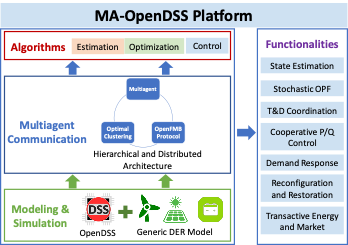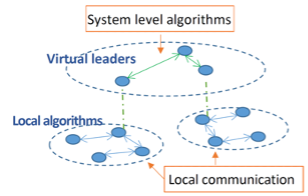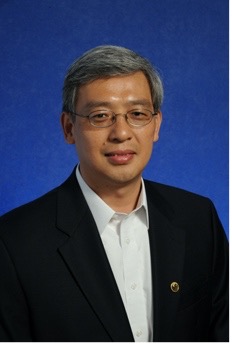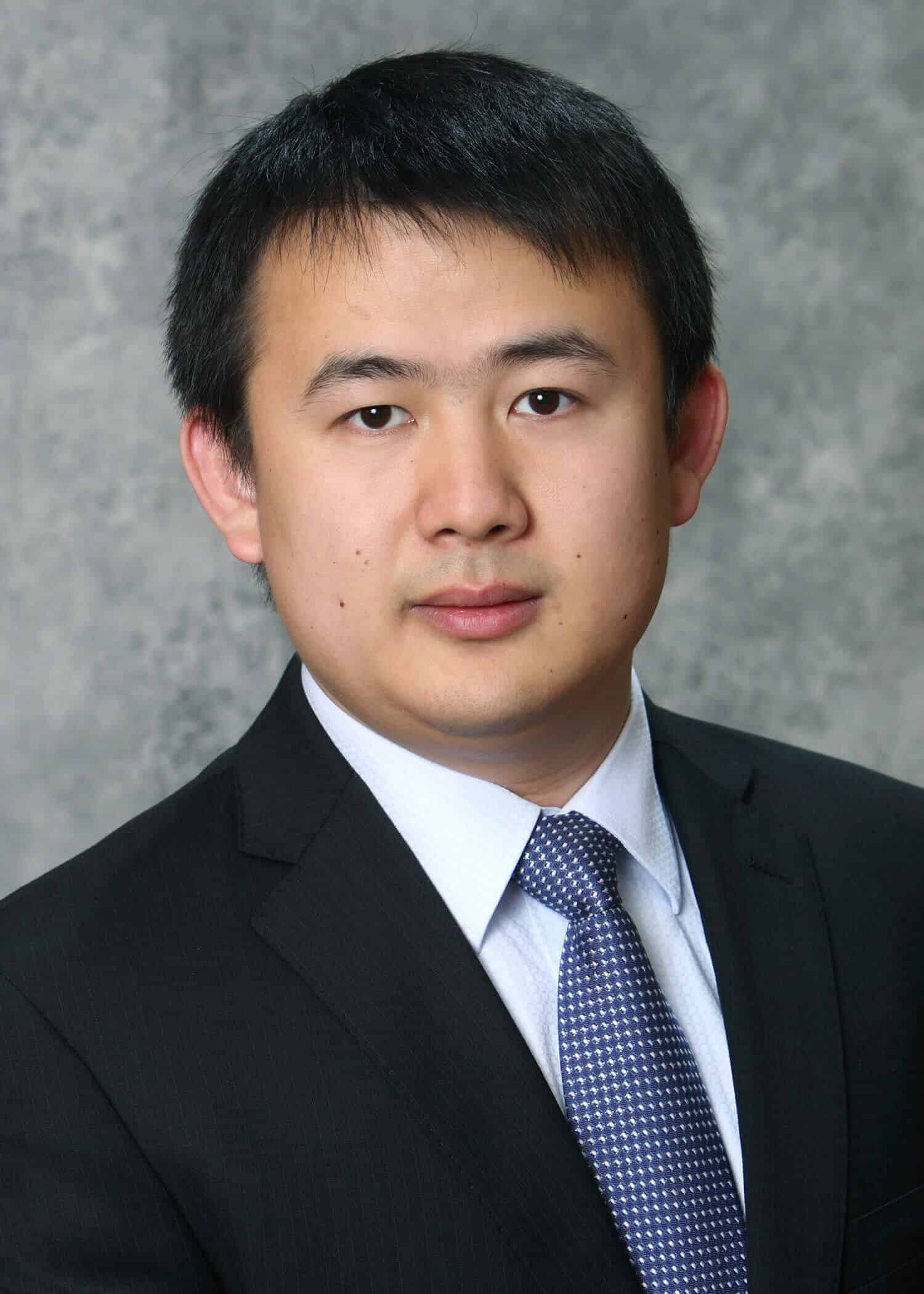Multi-Agent OpenDSS, An Open Source and Scalable Distribution Grid Platform
Written by Ying Xu, Inalvis Alvarez-Fernandez, Zhihua Qu, and Wei Sun
University of Central Florida
The open source Distribution System Simulator, OpenDSS, is a comprehensive electrical power system simulation package for electric utility power distribution systems. It has two modes: sinusoidal steady-state simulation, and time series (or quasi steady-state) simulation. Both are very efficient and useful for many analyses. Multi-Agent OpenDSS, MA-OpenDSS, is built upon OpenDSS. The MA-OpenDSS incorporates an asynchronous, local, possibly varying communication architecture, enables a set of virtual nodes (called virtual leaders) to coordinate local data sharing and actions, includes programmable dynamic blocks for behaviors of distributed energy resources, and implements a host of distributed and cooperative algorithms of estimation, optimization and control, as shown in Figure 1. It is specifically developed to simulate and investigate self-organizing microgrids and large-scale electricity distribution networks with extremely high renewable penetrations. This article provides a summary of MA-OpenDSS main features and functionalities.

Figure 1. The MA-OpenDSS platform.
The MA-OpenDSS platform consists of three major components, 1) the modeling & simulation engine is based on the OpenDSS with added functions including, generic distributed energy resource (DER) modeling to implement distributed control strategy, solver improvements to include distributed control, distributed communication modeling, and data processing and visualization; 2) the multi-agent system architecture includes a hierarchical and distributed communication and control architecture, shown in Figure 2, combined with the OpenFMB standard to enable the lower level communication between intelligent entities and nodes, and the upper level communication between intelligent devices and a central system operator; and 3) the solution algorithms include distributed estimation, control and optimization [1], which enable advanced functionality at both the device and local levels and integrate them into the system level in a fully modular manner and with enhanced system-level solutions. These innovations build up a modular, plug-and-play, and scalable platform for real-time operation and control of large-scale distribution networks with high DER penetrations.

Figure 2. The unique communication design in MA-OpenDSS.
The MA-OpenDSS platform also enables the development of advanced distribution management system functions, including 1) an online multi-level distributed stochastic optimal power flow (OPF) based on a reverse-forward engineering procedure and dynamic, real-time, distributed feedback control for three-phase unbalanced distribution system; 2) an online distributed system state estimation (SE) algorithm based on prediction-correction methods for time-varying convex optimization, and with the joint real-time SE-OPF solver to calculate OPF based on the estimated voltage for more practical implementation; 3) the distributed Volt/VAR optimization and frequency control algorithms to optimally dispatch the real and reactive power of multiple DERs based on distributed cooperative control and optimization, with the robust performance against communication delays; 4) the distributed distribution system restoration strategy to optimally determine the PV generation, network configuration, switching status, and load pickup, in order to restore the entire system or energize unfaulted out-of-service areas, as well as to coordinate the restorative actions between transmission and distribution networks; and 5) the distributed PV hosting capacities with cooperative Volt/VAR and Volt/VAR/Watt control to provide recommendations for customers and the utility company.
Moreover, the advanced functions are tested in 1 million (1M)-node distribution system on the MA-OpenDSS platform. The 1M-node distribution system has been designed by combining ten 100k-node test systems from two larger fully synthetic test systems from NREL and San Francisco Bay Area. Furthermore, a two-stage greedy search algorithm is developed to find a realistic worst-case scenario for 100% PV penetration, considering both the location and the size of the PVs in the primary and secondary nodes of a feeder, in order to validate the effectiveness of the developed distributed functionalities [2].
Conclusions: The MA-OpenDSS is an effective, open-source tool to conduct simulations of DERs and their controls in distribution and/or transmission networks. It has been available and used in several settings: 1) Enhanced OpenDSS-G (OpenDSS Graphical User Interface) which includes MA-OpenDSS functionalities allowing the user to visualize and interact more directly with the distribution network and all its elements without needing to code [3]; 2) Simulation of distribution network with large-scale and/or small-scale PV/DERs (either 2019-version integrated into OpenDSS [4] or the 2021 updated version [5]); 3) Co-simulation of transmission and distribution network with high-penetration DERs; 4) Hardware-in-the-loop (HIL) and power hardware-in-the-loop (PHIL) simulations; and 5) Integration with other open-source tools (such as OpenFMB and Helics) as well as commercial software (such as ADMS and/or DERMS) for real-time implementation.
To the best of our knowledge, MA-OpenDSS is the first and only platform that can be used as a planning tool to systematically perform control-enabled hosting capacity analysis. When used as a real-time control and optimization tool, it can eliminate or substantially reduce curtailment through effective reactive and active power controls. These features enable and support extremely high penetration of PVs.
References
- Y. Xu, W. Sun, and Z. Qu, “Renewable Energy Integration and System Operation Challenge: Control and Optimization of Millions of Devices" in New Technologies for Power System Operation and Analysis, Academic Press, October 2020.
- M. Rathbun, Y. Xu, R. Roofegari Nejad, Z. Qu, and W. Sun, “Impact Studies and Cooperative Voltage Control for High PV Penetration,” 10th IFAC Symposium on Control of Power and Energy Systems, Tokyo, Japan, September 2018.
- https://sourceforge.net/projects/dssimpc/
- https://sourceforge.net/projects/electricdss/
- http://www.ece.ucf.edu/~qu/MA-OpenDSS/
This article edited by Hossam Gabber
For a downloadable copy of the May 2021 eNewsletter which includes this article, please visit the IEEE Smart Grid Resource Center.




To have the Bulletin delivered monthly to your inbox, join the IEEE Smart Grid Community.
Past Issues
To view archived articles, and issues, which deliver rich insight into the forces shaping the future of the smart grid. Older Bulletins (formerly eNewsletter) can be found here. To download full issues, visit the publications section of the IEEE Smart Grid Resource Center.




